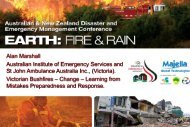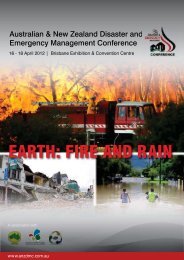Book of Abstracts 2013 - Australian and New Zealand Disaster ...
Book of Abstracts 2013 - Australian and New Zealand Disaster ...
Book of Abstracts 2013 - Australian and New Zealand Disaster ...
Create successful ePaper yourself
Turn your PDF publications into a flip-book with our unique Google optimized e-Paper software.
Mr Mark Armstrong<br />
Director, Full Capacity<br />
St<strong>and</strong>ing ready for the worst………How the QLD state disaster coordination centre (SDCC)<br />
response capability was conceived <strong>and</strong> deployed in less than twelve months<br />
The Queensl<strong>and</strong> State <strong>Disaster</strong> Coordination Centre (SDCC), whilst an impressive <strong>and</strong> well-equipped physical facility, is<br />
only as good as the people who staff it during a disaster. During a complex emergency the required staff for the SDCC<br />
needs to swell dramatically in order to effectively manage a statewide response. Regional disasters in recent years<br />
proved the difficulty in surging a staff sufficient to operate the SDCC in quantity, let alone quality. This had many<br />
negative consequences during emergencies; notably senior SDCC staff engaged in the time consuming tasks <strong>of</strong> seeking<br />
release <strong>of</strong> people from other government departments <strong>and</strong> negotiating issues such as staff hours. Critically, the staff<br />
that were released <strong>of</strong>ten lacked even a fundamental underst<strong>and</strong>ing <strong>of</strong> State <strong>Disaster</strong> Management Arrangements or<br />
SDCC operations resulting in urgent on-the-job training <strong>and</strong> ad-hoc induction. This capability gap was the first issue<br />
addressed by the newly formed <strong>Disaster</strong> Management Services Unit in early 2012. Through systematic planning,<br />
extensive consultation <strong>and</strong> vigorous execution an ’SDCC Response Team’ capability was justified, created <strong>and</strong> trained in<br />
less than a year. This capability was centered on a pool <strong>of</strong> trained, volunteer public servants st<strong>and</strong>ing ready to rapidly<br />
augment the SDCC in the event <strong>of</strong> crisis. The ’SDCC Response Team’ capability was deployed during the weather <strong>and</strong><br />
flood events <strong>of</strong> early <strong>2013</strong>. Initial feedback is that it was a great success resulting in an SDCC that ramped up faster <strong>and</strong><br />
operated more effectively, cohesively <strong>and</strong> sustainably than in the past. This paper, using the ‘ends-way-means’ model <strong>of</strong><br />
policy implementation, will examine how this initiative was developed <strong>and</strong> deployed so quickly. It will also consider<br />
how this augmentation approach could be used to enhance disaster management arrangements at the local or district<br />
levels using public or commercial resources.<br />
Dr Sharon Atkin<br />
State Manager Research, UnitingCare Community<br />
Co Author - Mr Redzo Mujcic, Senior Researcher, UnitingCare Community<br />
Longer term individual <strong>and</strong> community needs after natural disaster: The experience <strong>of</strong><br />
Central Queensl<strong>and</strong><br />
Lifeline (as part <strong>of</strong> UnitingCare Community), along with other government <strong>and</strong> non-government organisations is a key<br />
signatory for the provision <strong>of</strong> Community Recovery Services following a disaster. Following the 2010-2011 flood<br />
disasters in Queensl<strong>and</strong>, Lifeline Queensl<strong>and</strong>, became concerned about the level <strong>of</strong> ongoing medium to longer term<br />
support available for the many rural <strong>and</strong> remote areas <strong>of</strong> Queensl<strong>and</strong>. The organisation decided that it was important<br />
to evaluate the services provided in these communities <strong>and</strong> developed a research project that was attached to the<br />
service provision. The purpose <strong>of</strong> the research was to evaluate need for such services, explore the impact for previously<br />
vulnerable individuals, explore engagement methods, evaluate effectiveness, look at changing needs across time, <strong>and</strong><br />
look at general community needs <strong>and</strong> service delivery gaps. The research was a mixed model design. Quantitative data<br />
about individuals seeking counselling from UnitingCare Community recovery counsellors was gathered from a survey<br />
completed by the counsellor. The survey consisted <strong>of</strong> the following domains: engagement, identified issues,<br />
relationships, health <strong>and</strong> social supports. Interviews were conducted with community recovery counsellors to gather<br />
qualitative data on the impact <strong>of</strong> the disasters on regions <strong>and</strong> individuals. The most frequently reported issues were<br />
financial stress, property damage, personal health, <strong>and</strong> relationship breakdowns; leading to a high dem<strong>and</strong> for<br />
counselling services. The services had a notable impact on the welfare <strong>of</strong> respondents, with most measures <strong>of</strong><br />
individual well-being improving over the initial four quarters <strong>of</strong> the survey. Such measures include client mental health,<br />
depression, level <strong>of</strong> anxiety, feelings <strong>of</strong> support, <strong>and</strong> coping levels. Nevertheless, there was a decline across the






